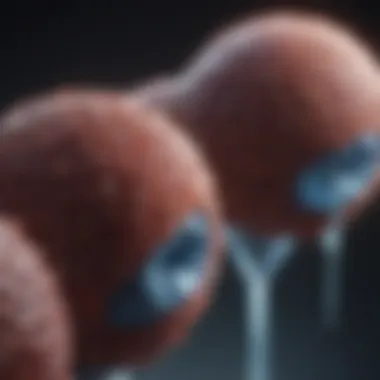Understanding the Role of Chemotherapy in Prostate Cancer


Intro
Prostate cancer is a significant health concern, especially among men aged 50 and older. As it develops, patients often face a complex decision about treatment options. Among these options, chemotherapy stands out as a commonly discussed modality. However, the necessity and timing of chemotherapy in prostate cancer treatment can be confusing. This article aims to clarify the role of chemotherapy in treating prostate cancer by examining various factors that determine whether it is required.
Research Highlights
Overview of Key Findings
Chemotherapy is not universally indicated for all stages of prostate cancer. Research indicates that chemotherapy is primarily utilized in advanced cases or when the disease becomes resistant to hormone therapy. Recent studies highlight several key findings:
- Chemotherapy is often reserved for metastatic castration-resistant prostate cancer (mCRPC) when other treatment options are exhausted.
- The effectiveness of chemotherapy can be influenced by the patient’s overall health and specific characteristics of the cancer.
- Novel therapies, such as immunotherapy and targeted treatments, have become increasingly important in managing prostate cancer, sometimes reducing the reliance on traditional chemotherapy.
Significance of the Research
Understanding when chemotherapy is needed is crucial not only for clinical decision-making but also for enhancing patient quality of life. Patients equipped with knowledge about their treatment options can engage more actively in discussions with healthcare providers about the merits and risks of chemotherapy.
"The choice of treatment should always consider the unique circumstances of the patient’s health status and the specifics of the cancer's progression."
Treatment Modalities
The treatment landscape for prostate cancer is diverse. It encompasses several modalities, each with its indications and timing. Common approaches include:
- Active Surveillance: Often recommended for low-risk patients to monitor the cancer without immediate treatment.
- Surgery: Typically involves a radical prostatectomy for localized disease.
- Radiation Therapy: Utilized for localized or advanced cancers, often offering a non-invasive option.
- Hormonal Therapy: A first-line treatment for advanced prostate cancer affecting testosterone levels.
- Chemotherapy: Introduced later, mainly for chemotherapy-sensitive stages or resistant cases.
These modalities may also be used in combination, and some patients may require chemotherapy as part of their treatment regimen, particularly when cancer does not respond to other therapies.
Patient Health Considerations
When determining the need for chemotherapy, nearly all health factors should be assessed. Some significant considerations include:
- The stage of cancer at diagnosis.
- Previous treatments and responses to them.
- The patient's overall physical condition and comorbidities.
- Patient preferences and lifestyle considerations.
These elements will guide oncologists in recommending a tailored approach to treatment.
Advanced Cases and Chemotherapy
In advanced prostate cancer, when the disease spreads to other parts of the body, chemotherapy frequently becomes a vital component of treatment. Studies show that drugs like docetaxel and cabazitaxel play crucial roles in treating mCRPC. For patients facing this advanced stage, discussing with physicians the potential benefits and side effects of chemotherapy is important to ensure informed decision making.
Understanding Prostate Cancer
Understanding prostate cancer is crucial for patients, families, and healthcare professionals. It allows for informed decisions regarding treatment options and management strategies. This section lays the groundwork for the entire discussion about prostate cancer, particularly in relation to chemotherapy. By grasping the fundamentals, patients can better engage in conversations with their healthcare providers and understand their treatment pathways.
Overview of Prostate Cancer
Prostate cancer occurs in the prostate, a small gland located below the bladder in men. The primary function of the prostate is to produce fluid that nourishes and transports sperm. Prostate cancer develops mainly from the cells in the prostate gland and can vary widely in aggressiveness. Some cancers grow slowly and may not pose a significant health risk, while others can spread quickly and necessitate immediate intervention.


Statistics and Prevalence
Prostate cancer is one of the most common cancers in men. According to statistics, about 1 in 8 men will be diagnosed with prostate cancer during his lifetime. The incidence rates can vary based on geographic location, ethnicity, and age. For instance, men over the age of 50 face a much greater risk of developing this disease. Furthermore, African American men have a higher incidence of prostate cancer compared to other ethnic groups, highlighting the importance of tailored screening strategies.
"Understanding the statistics provides insight into the significance of prostate cancer in male populations, motivating early detection and treatment interventions."
Risk Factors
Several risk factors contribute to the likelihood of developing prostate cancer. Some of the key factors include:
- Age: The risk increases significantly as men age, particularly after 50.
- Family History: A man with a father or brother who had prostate cancer is at higher risk.
- Race: As mentioned, African American men are more likely to be diagnosed than white or Asian men.
- Diet: A diet high in red meat and dairy products may contribute to increased risk.
- Obesity: Excess body weight has been linked to a higher chance of developing aggressive prostate cancer.
These factors not only delineate who may be at risk but also inform screening and prevention strategies. Recognizing these elements is essential for proactive health management.
Treatment Options for Prostate Cancer
Prostate cancer treatment is a complex field that requires careful consideration of various options. Understanding treatment modalities is crucial for patients and families facing this diagnosis. Each treatment has its specific indications, benefits, and potential drawbacks. Good knowledge about these options can help patients make informed decisions.
Surgery
Surgery for prostate cancer typically involves a procedure known as a prostatectomy. This involves the removal of the prostate gland along with some surrounding tissue. This option is often recommended for patients with localized prostate cancer. The main goal is to eliminate cancer completely.
After surgery, there may be a recovery period needed. Patients may experience side effects, including urinary incontinence and erectile dysfunction. Discussing these risks with a healthcare professional is important. Surgical options can vary based on the patient's age and overall health.
Radiation Therapy
Radiation therapy is another major treatment option. It uses high-energy rays to target and kill cancer cells. There are two main types of radiation therapy for prostate cancer: external beam radiation and brachytherapy.
External beam radiation involves delivering focused radiation from outside the body. Brachytherapy involves placing radioactive seeds directly into or near the tumor. Both methods can be effective, depending on cancer stage and patient preference.
Side effects may include fatigue, skin irritation, and changes in urinary habits. Patients should weigh these factors when considering radiation therapy.
Hormone Therapy
Hormone therapy aims to reduce levels of male hormones, particularly testosterone, which can fuel the growth of prostate cancer. This treatment is often used for advanced cancer or when other therapies have not been successful.
Common hormone therapy methods include medications that block hormone production or action. Side effects may include fatigue, weight gain, and hot flashes. Understanding how these treatments fit into the overall management of prostate cancer is essential for informed patient choices.
Chemotherapy Overview
Chemotherapy is generally not the first-line treatment for prostate cancer. However, it plays a role in specific advanced stages, particularly when the cancer is no longer responding to hormone therapy. The role of chemotherapy is increasingly important in treating aggressive prostate cancers.
Chemotherapy regimens can vary, but they often involve multiple cycles. Side effects can include nausea, hair loss, and increased susceptibility to infections. Patients must navigate these challenges, understanding when chemotherapy becomes necessary in their treatment plan.
"Chemotherapy is a serious treatment that can have significant implications. Weighing all options is vital for patients and families."
When is Chemotherapy Recommended?


Understanding when chemotherapy is necessary for prostate cancer is crucial for clinicians and patients alike. Determining the appropriate timing for chemotherapy can significantly influence treatment outcomes and survival rates. This section delves into critical aspects that dictate when chemotherapy becomes an essential part of the treatment plan. Key factors include the stage of cancer, the health status of the patient, and how well the cancer responds to other treatments.
Cancer Stage and Progression
The stage of prostate cancer plays a pivotal role in treatment decisions, including the recommendation for chemotherapy. Prostate cancer is usually classified into various stages based on the extent of its spread. Early-stage cancers may respond well to localized treatments such as surgery or radiation therapy. In contrast, more advanced stages, like metastatic prostate cancer, often necessitate chemotherapy.
Chemotherapy is generally recommended for patients exhibiting:
- Advanced or Metastatic Disease: If the cancer has spread beyond the prostate gland to other organs, systemic therapy may be required.
- Rapid Progression: When prostate cancer cells proliferate quickly, immediate intervention with chemotherapy could be vital.
"Understanding disease stage helps clinicians tailor treatment, ensuring that patients receive only the most appropriate therapeutic interventions."
Advanced cancer stages indicate a complex interaction with other systems in the body, making chemotherapy a critical option to control disease progression.
Patient Health Assessment
The overall health of the patient is another determining factor in recommending chemotherapy. A thorough assessment of the patient’s health ensures that they can tolerate the side effects often associated with chemotherapy. Factors considered in this assessment include:
- Age: Older patients may have decreased resilience to chemotherapy.
- Existing Health Conditions: Comorbidities like heart disease or diabetes can affect a patient’s ability to handle chemotherapy.
- Overall Physical Condition: Patients in good health are typically better suited for chemotherapy.
Before initiating chemotherapy, healthcare providers may perform various tests. These tests can include blood tests, imaging studies, and health evaluations to gauge a patient's fitness for treatment. Such comprehensive assessments help clinicians make informed decisions tailored to the individual patient.
Response to Other Treatments
Often, the response of prostate cancer to previous treatments significantly influences recommendations for chemotherapy. If a patient does not respond adequately to standard therapies—such as surgery, radiation, or hormone therapy—chemotherapy may be considered as a secondary treatment option. Factors to consider include:
- Resistance to Hormone Therapy: Once cancer becomes resistant to hormone treatments, chemotherapy may be necessary to re-establish disease control.
- Recurrence After Local Treatment: If cancer returns after initial localized treatment, chemotherapy might be introduced to manage the disease more effectively.
An ongoing dialogue between physicians and patients is vital throughout the treatment journey. This ensures that treatment is adjusted based on how the cancer responds to initial therapies. By remaining adaptable and responsive, healthcare professionals can optimize treatment outcomes for prostate cancer patients.
The Role of Chemotherapy in Advanced Prostate Cancer
Chemotherapy plays a pivotal role in the treatment of advanced prostate cancer. This form of cancer can progress to a stage where it becomes resistant to hormone therapy and other conventional treatments. At this point, chemotherapy may provide the necessary intervention to manage disease progression. Understanding the specifics of chemotherapy's role can help patients, families, and healthcare providers make informed decisions regarding treatment options.
Chemotherapy Regimens
Chemotherapy regimens for advanced prostate cancer typically involve a combination of medications that target rapidly growing cancer cells. The regimens often start with docetaxel or cabazitaxel, which have shown effectiveness in clinical trials. These drugs may be used alone or in combination with prednisone to enhance efficacy.
- Docetaxel: This is typically the first-line chemotherapy option. Administered every three weeks, it has been shown to extend survival in specific patient groups.
- Cabazitaxel: Often used for patients who have progressed after docetaxel, cabazitaxel is given in combination with prednisone. It provides a further treatment avenue, especially for those resistant to initial therapies.
While these agents have been shown to improve survival rates, adherence to treatment schedules is critical. Patients must consult with their oncologists to tailor the regimen according to their specific health conditions and cancer progression.
Side Effects and Management
Despite the potential benefits, chemotherapy is not without its challenges. The medications involved can induce various side effects that may affect a patient's quality of life. Common side effects include:
- Fatigue
- Nausea and vomiting
- Loss of appetite
- Hair loss
- Risk of infections due to lowered white blood cell counts


Management strategies can significantly alleviate these side effects. For instance, anti-nausea medications can help mitigate vomiting. Nutritional support is crucial to combat loss of appetite and maintain body strength.
"Understanding the side effects of chemotherapy is essential for proactive management and improving patient comfort."
Patients should maintain open communication with their healthcare teams to address side effects promptly. Adjustments to the treatment plan, such as changing dosage or switching agents, may sometimes be necessary to enhance tolerability. Monitoring health closely will allow for timely interventions, which is crucial in ensuring the effectiveness of chemotherapy while minimizing disruption to daily life.
In summary, chemotherapy represents a critical option for advanced prostate cancer. It involves specific regimens that can significantly impact survival, although side effects must be managed effectively. Educating patients about these elements is essential for successful treatment outcomes.
Emerging Research and Future Directions
Emerging research in prostate cancer treatment, specifically regarding chemotherapy, offers new perspectives for practitioners and patients alike. The landscape of treatment is constantly evolving due to advancements in technology, molecular biology, and pharmacology. These developments help tailor therapy more effectively to the diverse nature of prostate cancer. Keeping abreast of recent studies and trials allows oncologists to apply findings that may significantly improve patient outcomes.
Novel Chemotherapy Agents
Recent investigations have led to the discovery of novel chemotherapy agents that target prostate cancer more effectively. Drugs like cabazitaxel exemplify advancements that have emerged from ongoing research. This agent has shown promise in cases where the cancer has not responded to traditional treatments.
Also, other investigational drugs are exploring mechanisms to minimize resistance that cancer cells often develop against standard chemotherapy. Researchers are focusing on drug combinations that can enhance synergistic effects, aiming to improve survival rates and reduce side effects. Additionally, clinical trials are continuously assessing the efficacy and safety profiles of these novel agents, making it a critical area for ongoing research.
Combination Therapies
Combination therapies are a significant focus in contemporary cancer management. These approaches involve using multiple agents or treatment modalities together to achieve better results than single-agent therapies. For example, combining chemotherapy with hormone therapy, such as abiraterone, can improve patient outcomes and delay progression.
Current studies are also examining the effectiveness of combining traditional chemotherapy with targeted therapies. Incorporating newer agents into established protocols offers hope for enhanced efficacy. Understanding the tumors’ biology is essential in determining the best combinations, thus personalizing treatment plans where possible.
- Benefits of combination therapies include:
- Broader mechanisms of action against cancer cells.
- Potential to lower treatment resistance.
- Delayed disease progression.
Personalized Treatment Approaches
Personalized treatment approaches are gaining traction among oncologists. This strategy involves tailoring the therapy based on the individual genetic profile of the patient’s tumor and their overall health status. Through genetic testing, specific mutations can be identified, guiding the choice of therapies that may be more effective.
Furthermore, these approaches foster a more comprehensive understanding of the disease, leading to better care plans that address patient needs holistically. Monitoring patient responses to treatment also helps in continuously refining therapy. The shift towards personalized medicine not only enhances treatment efficacy but also minimizes unnecessary side effects, ensuring a better quality of life during treatment.
Advances in emerging research show great potential in enhancing how prostate cancer is approached and treated, paving the way for optimized patient care.
The End
In this article, we have dissected the intricate relationship between chemotherapy and prostate cancer. Understanding when chemotherapy is required can significantly influence treatment outcomes. This conclusion encapsulates key points discussed, aiding patients and their families in making informed decisions about their treatment paths.
Summary of Key Points
- Chemotherapy is not the first line of treatment for most prostate cancer cases.
- It is primarily considered for advanced stages or when other treatments have failed.
- The patient’s overall health, cancer stage, and response to prior treatments shape the decision.
- Emerging research shows promise with novel chemotherapy agents and combination therapies.
While chemotherapy may not always be essential, it plays a vital role in specific advanced scenarios, offering hope when other treatments falter. Understanding these dynamics allows patients to engage proactively with their healthcare providers.
Implications for Patients
For patients battling prostate cancer, the discussion about chemotherapy is crucial. It emphasizes the need for a tailored approach to treatment that considers individual health and cancer specifics. The implications are profound:
- Informed Decisions: Patients should educate themselves about their treatment options, knowing that chemotherapy may be necessary in certain stages but not always.
- Quality of Life Considerations: Patients need to weigh the potential side effects of chemotherapy against benefits, alongside their overall health.
- Advancements in Treatments: Keeping abreast of new research can provide hope and options that might suit their particular circumstances.
Patients equipped with knowledge are better positioned to navigate their journey with prostate cancer. Engaging with healthcare providers, asking questions, and considering second opinions can be pivotal in the treatment process.







